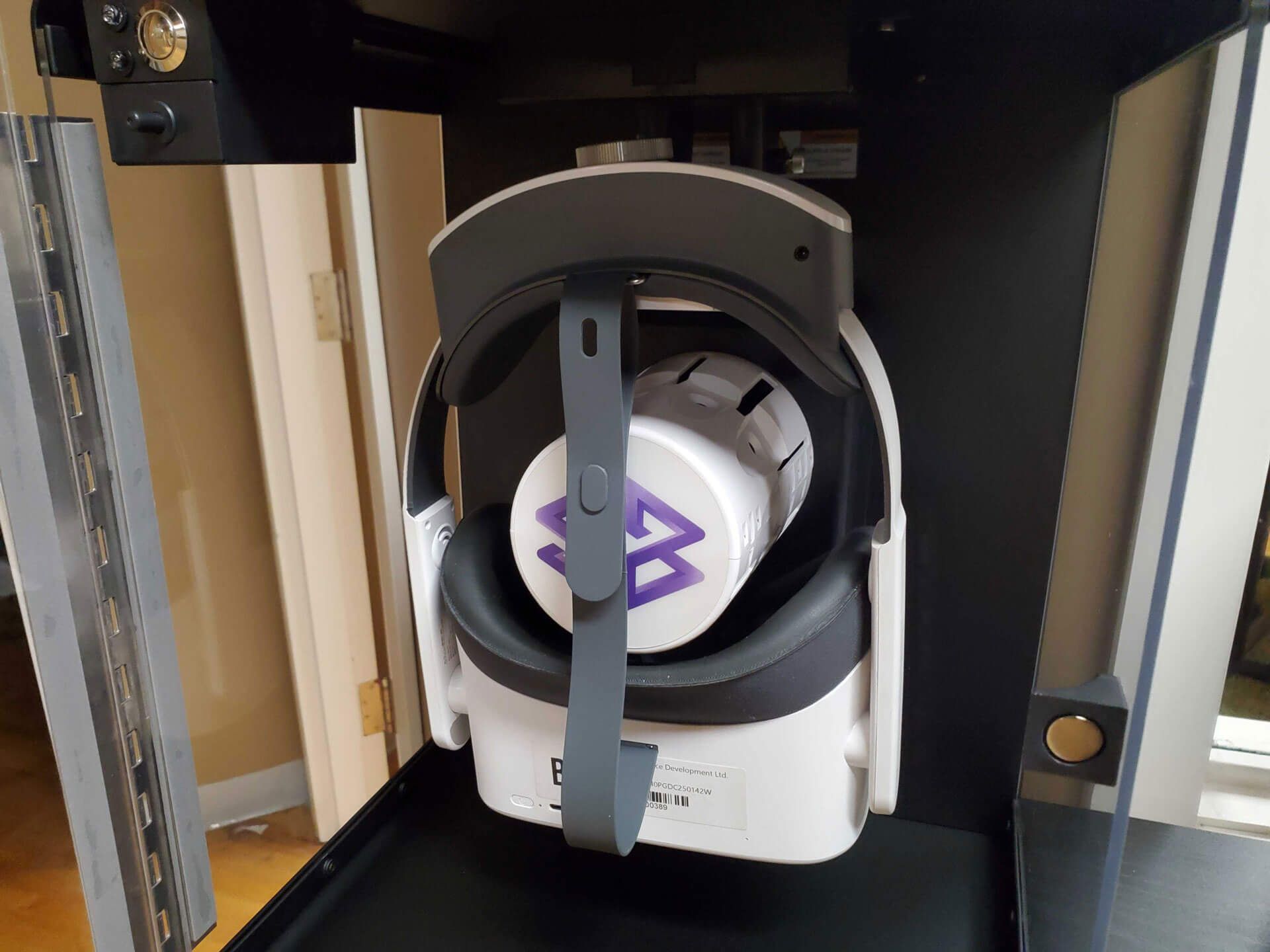How to Keep Your VR Headset Clean Post Covid-19
This guide is for anyone who shares a VR headset with others, be it at a public event, at work, or home with friends and family. Mostly everyone who owns a VR device should follow these practices.

By Kevin Carbotte
Keeping your VR headset clean is more important t han ever in this post-Covid19 world. VR headsets have always been a hotspot for potential germ transmission, especially at trade shows where dozens of people will share the same headset in a day.
As VR developers, we’ve been to our fair share of events and demos to promote our wares, so we’re intimately familiar with the challenges of keeping things sanitary for our guests.

How do I keep my VR headset clean?
If you’re going to share a VR device, you must have a way to clean the headset between uses, but VR devices aren’t as easy to clean as you might expect.
Obviously, you can’t dump your electronics into a sink of soap and hot water to clean them. Headset manufacturers will tell you that the best thing to use is non-abrasive anti-bacterial wipes. Alcohol-based cleaning wipes can damage the outer surface, the sensors, and the lenses in your headset.
Baby Wipes Won't Cut It
The easy solution used to be to use non-alcohol baby wipes and a microfiber towel, but it turns out that’s not good enough in our new reality. The coronavirus that carries Covid-19 is not affected by standard baby and anti-bacterial wipes.
Researchers concluded that the SARS-CoV-2 virus could survive on surfaces for as long as 72 hours, and it takes a 60% to 80% concentration of Ethanol to kill the virus. But you shouldn’t use that on your electronics.
So, what’s the best option?
Well, the simple answer is there aren’t many reasonable solutions right now. As far we’re aware, you can’t buy a cleaning detergent or sanitizing wipe that will kill SARS-CoV-2 that doesn’t damage VR equipment. The truth is, everyone needs to make concessions and put some money in the budget towards keeping things sanitary.
If you’re going to use ethanol-based cleaners, expect your hardware to fail early. The plastic may get brittle over time, and some sensors may eventually stop working correctly.
The other option is to invest in additional equipment to keep your VR hardware clean and safe. There are several things that you can do to reduce the volume of germs on your VR equipment, but it all starts with preventative measures.
Wipeable Cushions Are a Must!
First thing’s first; make sure your VR equipment is easy to wipe down. That probably means you’re going to need some upgrades.
Wipeable face cushions are an absolute must when you’re sharing your headset. Without a moisture-repellent surface, the foam cushions absorb sweat like a sponge. No one wants to put a sweaty headset on after someone else has used it, and that is especially true when there’s a deadly virus spreading around the world. With the proper equipment, it’s easy to keep your headset fresh and clean.
You want a headset that has wipeable face cushions that don’t absorb sweat. Some headsets, like the new lineup of Pico G2 standalone VR devices , come with pre-installed PU (polyurethane) covers. Others, like the Oculus Quest, Rift S, and HTC Vive Pro Eye headsets, require an aftermarket upgrade from a company like VRCover to make them sweat-resistant.
Check out our Business VR Headset Buyers Guide for more information about the different headsets.

Keep Extras On-Hand
At an event where you’re going to have many people cycling through the same headset, you should have extra face cushions and the ability to clean them on-site. Every person should get a fresh face cushion, and we’re not talking about the disposable kind. Disposable face covers won’t protect anyone from a contaminated, sweaty headset.
The PU covers can take a bit of abuse, but they will break down over time if you consistently use alcohol to clean them, so keep that in mind.
Don’t forget the Controllers
It’s easy to forget about cleaning the controllers, but it is just as important as cleaning the headset. Many VR experiences require significant activity from the player, and some experiences put you in unnerving situations like standing at the top of a high-rise. It’s not uncommon for people’s hands to get sweaty when they are in VR. Sweating is also one of the symptoms of motion sickness.
There are a handful of third-party vendors that sell silicone covers for your controllers, which should make them easier to clean because they should hold up to some cleaners.
Never spray anything on the lenses. Stick with a microfiber lens cloth. No one should have their fingers on the lenses anyway.

Exotic Hygiene Options
The best solutions for keeping your VR hardware sanitary are even more on the cutting edge than VR technology itself. UV light is the most effective way to clean your headset and controllers without damaging the equipment.
But don’t rush out and buy a bunch of black lights just yet. There are three types of Ultraviolet light; UVA, UVB, and UVC.
UVA and UVB are the kind of ultraviolet light that comes from the sun, and they can damage the screens and sensors on your headset. UVC operates at a lower wavelength (100-280nm), which does not damage electronic equipment. Still, it does destroy the DNA of micro-organisms and viruses and thus can decontaminate your electronics, including VR equipment.
UVC Decontamination
UVC light is hazardous to work with and can cause damage to your skin under direct contact. Fortunately, a company called Cleanbox Tech offers a safe way to clean your electronics with UVC light.
Cleanbox Technologies engineered thier decontamination boxes to kill all the bacteria and viruses on a headset in as little as 60-seconds. The Cleanbox units use a combination of concentrated UVC light and high-velocity air to rapidly clean and dry your headset. Cleanbox CX series comes in single, double, and 4-bay options.

Nano Technology
For the Cleanbox solution to work to its full potential, it also requires a nanotechnology spray the repels liquids. In other words: this nanotech spray makes any surface waterproof.
The nanotech coating prevents sweat and oils, and even makeup from soaking into the fabrics and staining the plastics of your headset. The surface coating lowers the chance of bacteria forming, and the UVC light kills anything that slips through.
Make VR Hygiene A Priority
Investing in a VR solution for training, education, or entertainment is already an expensive prospect, but it’s not worth cutting corners when it comes to the health and well-being of others. It will cost a little bit extra up front but in the long run the investment in proper VR hygiene will page for itself by extending the life of your equipment and protecting the health of your guests or patrons.
Click to share this article
Transform your business with immersive technologies
Schedule a consultation to see how BSD can help your organization unlock new avenues of engagement.
CONTACT US
Global Headquarters
1555 Dublin Avenue, R3E 3M8
Winnipeg, MB, Canada
PUBLIC RELATIONS
DIVISIONS
GENERAL
IN THE SPIRIT OF RECONCILIATION
We would like to acknowledge that the land on which we gather is Treaty One Territory, the home and traditional lands of the Anishinaabe (Ojibwe), Ininew (Cree), and Dakota peoples, and in the National Homeland of the Red River Métis. Our drinking water comes from Shoal Lake 40 First Nation.
Join 10,000+ people who get XR tips, insights, and company updates monthly.
Contact Us
We will get back to you as soon as possible.
Please try again later.
Privacy Policy Accessibility Sitemap Support
Bit Space Development Ltd.





